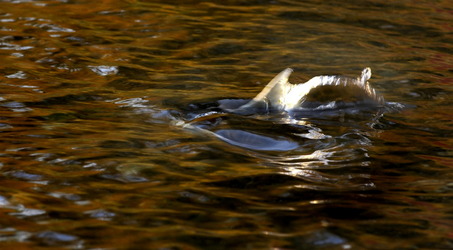forum
library
tutorial
contact

Idaho Officials Unhappy with Neighbor States
by Eric BarkerLewiston Tribune, June 13, 2009
|
the film forum library tutorial contact |

|
Idaho Officials Unhappy with Neighbor States
by Eric BarkerLewiston Tribune, June 13, 2009 |
 The Idaho Fish and Game Commission is planning to write letters to its counterparts in Oregon and Washington to complain about the way those states manage spring chinook fisheries in the lower Columbia River.
The Idaho Fish and Game Commission is planning to write letters to its counterparts in Oregon and Washington to complain about the way those states manage spring chinook fisheries in the lower Columbia River.
Fisheries officials in Idaho say that anglers in Oregon and Washington caught more chinook in 2008 that came from Idaho hatcheries than Idaho anglers did. They assume the numbers will be the same this year.
"It ended up there were a lot of fish destined for this part of the world that got caught in the lower (Columbia) River," said Fred Trevey of Lewiston, the commissioner who represents the Clearwater Region.
Larry Barrett, a fisheries biologist for the Idaho Department of Fish and Game at Lewiston, said based on information gleaned from coded wire tags implanted in many salmon, more chinook from Idaho hatcheries were caught in the Columbia River below Bonneville Dam than were caught by Idaho anglers in the Clearwater, Salmon and Snake rivers.
"They took 4,000 Clearwater River fish in the fishery below Bonneville last year ,and we harvested totally in the Clearwater drainage about 3,200. It's likely going to be the same this year," he said. "It's not a stretch to think they slick off the first part of this Clearwater run in that fishery down there."
In the 2008 spring and summer chinook fishery, Barrett said anglers in the lower Columbia caught more than 5,000 chinook destined for the Rapid River hatchery near Riggins, compared to 3,300 caught on the lower Salmon and Little Salmon rivers.
Trevey would like Idaho to have a formal role in setting allocations for the hatchery component of the annual chinook run. Right now, Idaho does not have a role in salmon allocations born out of the U.S. v. Oregon court case. The process involves Oregon, Washington, federal salmon managers and the Columbia River treaty tribes, including the Nez Perce.
The tribes complained this year that too many salmon have been caught in the lower Columbia River, and it has curtailed upriver tribal fishing.
Both commercial- and sport-fishing seasons on the lower Columbia are based on preseason run forecasts. Those forecasts often turn out to be wrong. This year, salmon managers predicted 298,000 chinook bound for the upper Columbia and Snake rivers would return to the mouth of the Columbia. Now, after the run started late, salmon managers say just 160,000 chinook could return to the river's mouth.
When the sport and commercial salmon-fishing seasons were opened on the Columbia, salmon managers didn't have the benefit of the new run forecast, and anglers caught upwards of 20,000 chinook before fishing was shut down.
Anglers and salmon managers in Idaho hope that happens soon enough to ensure the hatchery run will still be abundant enough for sport fishing when the chinook reach Idaho.
It is not just Idaho anglers who may have something to complain about.
The lower Columbia River fishery also played a role in limiting salmon fishing opportunities in eastern Washington. The salmon fishery near Little Goose Dam in Washington was shut down just as the fishing was starting to get good. Seasons planned near Ice Harbor and Lower Granite dams never opened.
"We were all hopeful this buffer was going to take care of the problem, but it didn't happen," said Glen Mendel, district fish biologist for the Washington Department of Fish and Wildlife at Dayton. "Something else is going to have to change."
learn more on topics covered in the film
see the video
read the script
learn the songs
discussion forum
